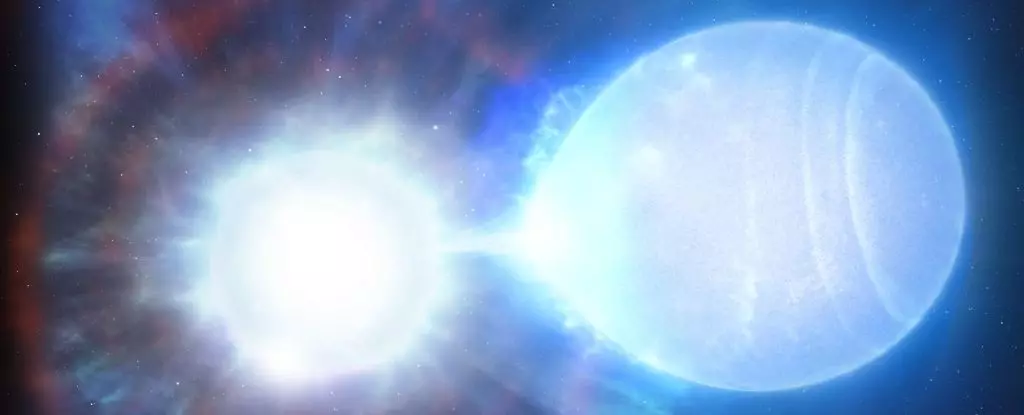In the grand theatre of the cosmos, stars are not everlasting beings. They undergo breathtaking transformations defined by birth, life, and inevitable death. Among the myriad of celestial bodies, binary star systems—where two stars orbit each other—present a riveting case study. Just recently, astronomers announced a monumental finding regarding a binary white dwarf system located approximately 150 light-years away, revealing that in an astonishing 23 billion years, these stellar remnants will collide in a spectacular Type Ia supernova explosion. This prediction, both exhilarating and slightly haunting, unravels new pathways in our understanding of the universe and its stellar evolution.
Unveiling the Secrets of Type Ia Supernovae
Type Ia supernovae serve as crucial cosmic beacons, assisting astronomers in measuring vast intergalactic distances. Previous theories had suggested that these supernovae originate from white dwarf stars, which are remnants of former main-sequence stars that have run out of nuclear fuel. However, the substantial breakthrough emerged with the realization that it often takes two white dwarfs in a binary system to trigger such explosive phenomena. For the first time, scientists have traced this celestial relationship directly, confirming long-held hypotheses that had remained untested until now.
Astrophysicist James Munday from Warwick University, who spearheaded this research, articulated the significance of their discovery adeptly. The proximity of this system to Earth, coupled with its impending fate, suggests that numerous similar systems could be lurking in the Milky Way, waiting to be identified and studied further. This revelation elevates the anticipation surrounding future observations and explorations of deep space.
The Life Cycle of White Dwarfs
White dwarfs are born from the remnants of stars that have exhausted their nuclear fuel. As these stars transition from vibrant giants to lifeless cores, they eject their outer layers, leaving behind a dense core that can squeeze the mass of up to 1.4 Suns into a volume comparable to that of Earth. This dense remnant, known as a white dwarf, illustrates nature’s capability to create extraordinary structures under the influence of gravity, showcasing the universe’s intricate and beautiful complexity.
The crucial cornerstone in the lifecycle of white dwarfs is the Chandrasekhar limit, above which a white dwarf cannot maintain its integrity. If the mass exceeds this threshold, a catastrophic collapse ensues, often resulting in a Type Ia supernova. These explosions not only release colossal amounts of energy but also scatter heavy elements into space, contributing to the cosmic matter that forms new stars, planets, and, thereby, life itself.
Revolutionizing Our Understanding of Cosmic Events
This exciting discovery of bipolar white dwarfs, designated as WDJ181058.67+311940.94, marks a pivotal advancement in our understanding of Type Ia supernova origins. With a combined mass of 1.56 times that of our Sun and a periodic orbit lasting over 14 hours, this binary system will experience a gradual spiral-in, unlocking the possibility of a future explosion that pinpoints the relationship between two stars and their eventual supernova outcome.
The implications of this discovery stretch far beyond mere celestial mechanics. As Munday points out, affirming a direct connection between double white dwarfs and Type Ia supernovae acts as a promising narrative framework from which we can expand our study of the galaxy. This finding not only enhances our comprehension of stellar lifecycles, but it also opens avenues for investigating the nature of dark energy, as Type Ia supernovae have been instrumental in elucidating the accelerating expansion of the universe.
Looking Ahead: A Cosmic Journey
As we look forward to what this newfound understanding brings, it’s essential to note that the implications of these cosmic destinies reach into the very fabric of our existence. The future explosion of WDJ181058.67+311940.94 will occur eons from now—when humanity and possibly even our own Sun will have expired. This cosmic narrative encourages both humility and wonder: our time in this universe, though fleeting, is punctuated by magnificent events that remind us just how interconnected the cosmos is.
The groundbreaking discovery of the binary white dwarf system serves as a reminder of diminishing light signals illuminating uncharted paths in cosmology. Understanding stellar explosions enables us to not only predict far-off cosmic events but also continuously redefine the boundaries of our astronomical knowledge. Each revelation reshapes our understanding of existence itself, rendering us passengers on an ever-evolving journey through space and time.


Leave a Reply